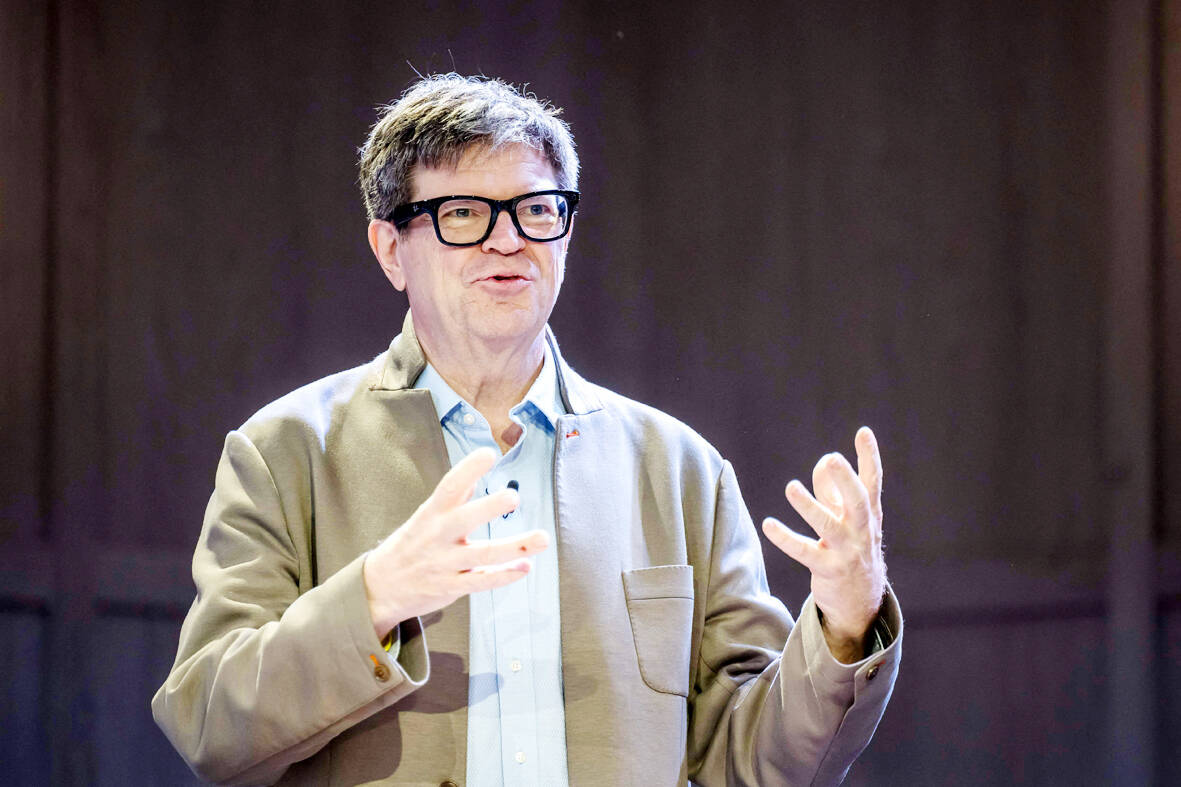One of the “godfathers” of modern artificial intelligence has predicted a further revolution in the technology by the end of the decade, and says current systems are too limited to create domestic robots and fully automated cars.
Yann LeCun, the chief AI scientist at Mark Zuckerberg’s Meta, said new breakthroughs are needed in order for the systems to understand and interact with the physical world.
LeCun spoke as one of seven engineers who were awarded the £500,000 (US$625,000) Queen Elizabeth prize for engineering on Tuesday for their contributions to machine learning, a cornerstone of AI.

Photo: AFP
Recent breakthroughs in the sector, led by the launch of OpenAI’s ChatGPT chatbot, have heightened expectations — and fears — of systems gaining human levels of intelligence.
However, LeCun said there was some way to go before AIs matched humans or animals, with the current cutting-edge technology excelling at “manipulating language” but not at understanding the physical world.
“There are still a lot of scientific and technological challenges ahead, and it’s very likely that there’s going to be yet another AI revolution over the next three to five years because of the limitation of current systems,” he said. “If we want eventually to build things like domestic robots and completely autonomous cars, we need systems to understand the real world.”
LeCun is working on systems that attempt to “understand” physical reality by forming a model that can predict how the world behaves. On current progress in AI, he said: “We’re not talking about matching the level of humans yet. If we get a system that is as smart as a cat or a rat, that would be a victory.”
However, LeCun’s fellow QEPrize winner and AI “godfather,” Yoshua Bengio, warned more progress was needed on the technology’s safety and called on next week’s global AI summit in Paris to grasp the issue.
“I’d like to see the leaders of this world to better understand the magnitude of what we are doing, both in terms of the power we’re creating, which could be for good or be dangerous, and the risks that come with that power,” he said.
In 2018, Bengio and LeCun shared the Turing award — seen as the equivalent of a Nobel prize for computing — with Geoffrey Hinton, who was also announced as a QEPrize winner on Tuesday. The award comes after AI pioneers won two Nobel prizes last year. They included Hinton — who shared the Nobel for physics with another recipient of this year’s QEPrize, the US physicist John Hopfield — and the Google DeepMind scientists among the winners of the chemistry prize.
Machine learning is a core process in developing AIs. Instead of being instructed directly, computers “learn” by analyzing data and then making informed decisions or predictions — such as what will be the next in a sequence of words.
The other winners of the 2025 QEPrize are: Li Feifei (李飛飛), the Chinese-American computer scientist who created ImageNet, a crucial dataset for training AIs to recognize objects; Jensen Huang (黃仁勳), the chief executive of Nvidia, the lead maker of chips used in operating and training AI systems; and Bill Dally, the chief scientist at Nvidia.
Patrick Vallance, the chair of the QEPrize foundation and the UK science minister, said the impact of machine learning was being felt across “industries, economies, and the planet,” The annual prize recognizes engineers whose innovations have a “significant impact on billions of lives around the world,” he said.

US President Donald Trump may have hoped for an impromptu talk with his old friend Kim Jong-un during a recent trip to Asia, but analysts say the increasingly emboldened North Korean despot had few good reasons to join the photo-op. Trump sent repeated overtures to Kim during his barnstorming tour of Asia, saying he was “100 percent” open to a meeting and even bucking decades of US policy by conceding that North Korea was “sort of a nuclear power.” But Pyongyang kept mum on the invitation, instead firing off missiles and sending its foreign minister to Russia and Belarus, with whom it

When Taiwan was battered by storms this summer, the only crumb of comfort I could take was knowing that some advice I’d drafted several weeks earlier had been correct. Regarding the Southern Cross-Island Highway (南橫公路), a spectacular high-elevation route connecting Taiwan’s southwest with the country’s southeast, I’d written: “The precarious existence of this road cannot be overstated; those hoping to drive or ride all the way across should have a backup plan.” As this article was going to press, the middle section of the highway, between Meishankou (梅山口) in Kaohsiung and Siangyang (向陽) in Taitung County, was still closed to outsiders

Many people noticed the flood of pro-China propaganda across a number of venues in recent weeks that looks like a coordinated assault on US Taiwan policy. It does look like an effort intended to influence the US before the meeting between US President Donald Trump and Chinese dictator Xi Jinping (習近平) over the weekend. Jennifer Kavanagh’s piece in the New York Times in September appears to be the opening strike of the current campaign. She followed up last week in the Lowy Interpreter, blaming the US for causing the PRC to escalate in the Philippines and Taiwan, saying that as

The Chinese Communist Party (CCP) has a dystopian, radical and dangerous conception of itself. Few are aware of this very fundamental difference between how they view power and how the rest of the world does. Even those of us who have lived in China sometimes fall back into the trap of viewing it through the lens of the power relationships common throughout the rest of the world, instead of understanding the CCP as it conceives of itself. Broadly speaking, the concepts of the people, race, culture, civilization, nation, government and religion are separate, though often overlapping and intertwined. A government